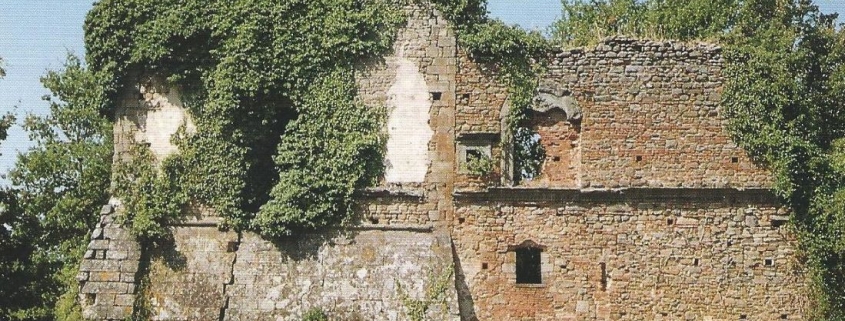Itinerary by car, motorcycle or bicycle 3 – The antique Ripulae
The antique Ripulae: From the origins to the Medieval
Type of route: paved, practical for cars, motorcycles and bikes. Walking trail for Palazzaccio di Marcignano
Duration: ½ day
Level of difficulty: easy
Bagno a Ripoli is a land with ancient origins. The proposed itinerary will bring the participant face to face with the traces of this rich past found throughout the hills, yet at the same time perfectly interwoven into the modern urban fabric. The path to discovering the antique Ripulae starts right in the middle of the city itself, where the ruins of a building and pavement in opus signinum (terracotta obtained by crushing bricks, tiles and of recyclable materials) can be found between Piazza della Pace and the local post office. Numerous coins and glass fragments have also been found, indicating the vitality of the city. Studies done on the archeological remains find that the size of the old Roman settlement is equivalent to the modern day city.
The excavations have also unearthed numerous layers of various structures; while attributable to many different periods, most of them can be dated to the Roman Empire (3rd century AD). This shows that even in very ancient times Bagno a Ripoli was considered to be in a strategic location in regards to communication and trade.
Leaving the excavations and the city center we will head towards Pontassieve, soon turning right on Via Villamagna. The eponymous hill is dotted with tower houses and castles. A notable example is the Rignalla Castle, an old fort converted into a villa by the Spinelli family, located in a splendid and dominating position overlooking the Arno valley and nearby streets. The building lost its 14th century appearance thanks to restoration works undertaken; the only medieval aspect that has survived is the crenelated wall. The Belforte and Monte Acuto Castles. are even more striking. However, both are privately owned and therefore can only be admired from afar. The first, due to the presence of the tall tower and the style of its windows and openings (reinforced by other structures over the course of the two centuries following its construction), can be dated to the first half of the 13th century. Several rounded arched brick openings can be admired on the eastern side, probably original features of the tower. The small windows on the northern side of the tower, however, have maintained their medieval design. Although the tower appears finished and then raised again due to the abrupt change in building material and style, on a whole it can be assumed that it constitutes the oldest part of the entire complex. Near the entrance to Castelbelforte a beautiful pietra serena stone basin is found, from which the upper section of another tower house, known as the Torre delle Nutrici, can be admired from afar. The tower can only be reached by means of a significant deviation from the planned route. The structure was substantially altered as can be noted by the masonry face that results very different from the lower levels of even and well-placed limestone rows, datable to the 13th century, and the reconstruction of the battlements.
Above Belforte, reached by taking the road that leads from Villamagna to the small village of Case San Romolo and then Vallina, stands the majestic Castello di Monte Acuto. As early as the 10th century there were reports of an austere fortress overlooking the Arno Valley. Property of the antique Compiobbesi family, natives of the Remole Parish and distinguished by their fierce Ghibelline beliefs, the Castle was then purchased by the Salviati family in the 15th century who later transformed it into a sumptuous villa. In 1571 Montauto went to the Acciaiuoli family, who had come to the area from Brescia in the distant 1160, by means of a nuptial gift. After a series of changes in ownership, the Castle was purchased by the Blasi Foglietti family (19th century) who in turn commissioned a student of Adolfo Copppedè, the celebrated father of Italian neo-Gothic, to restore the building. In reality the building was subjected to a substantial remodeling and restyling that affected both the façade facing Villamagna and the ancient tower. The changes to the overall appearance of the Castle were not liked by the famous scholar and critic Lensi Orlandi Cardini, who later defined it as a castle for puppets. During WWII the Castle was severely damaged during the bombing campaign to liberate Bagno a Ripoli. Fortunately, however, the tower and small St. James chapel, home to a fresco attributed to Francesco Granacci, were left intact.
Returning back down it is recommended to head back to Grassina and take Via di Tizzano towards San Polo. Near the small village of Quarate we will find a castle of the same name. The Castle is famous for its tower, known as the tower of the olive, thanks to the olive tree that grows atop it.
On the hill in front of the Quarate tower, set in an ancient chestnut and oak forest at the beginning of the Fontesanta Park, we find the striking Palazzaccio di Marcignano. It is not easy to reach, but its beauty is worth the adventure. Therefore, from Quarate take the Via di Poggio al Mandorlo (be careful: the road is unpaved and quite rough in some spots, but passable by car) until reaching the junction with Via delle Tavernuzze. Turn left and proceed for about 300 meters until you see a barred pathway to the right. Leave your car and follow the path through the beautiful forest until reaching a large clearing where you will find the ruins of the Palazzaccio. The large structure is completely overrun with vegetation, particularly ivy, evoking a scene straight from romantic literature. Despite its poor state of preservation, at least two distinct phases of construction can be detected. The first phase can be identified in the lower part of the tower and several portions of lower walls; the second phase claims the upper levels of the entire structure and is characterized by an elegant decorative sandstone mullioned window dating back to the early 15th century. It was then that the Rinuccini family, owners at the time, described the structure as a “tower with fortress”.
For those who wish to proceed with the discovery of this magical place, it is recommended that you continue climbing the hill along the path that leads from Palazzaccio to Casa Gavignano, a rural residence built on the ruins of a fort. After a few hundred meters through the dense forest, staying on the path bordered by a stone wall and marked with CAI indications to Tizzano, you will find the famous Etruscan inscription SassoScritto.
The visit to the antique Ripulae concludes in the village of Antella, whose ancient origins have been confirmed by multiple Etruscan findings (such as an architectural fragment in sandstone), and the ruins of the Roman Villa of Publio Alfio Erasto.
This post is also available in: Italian



